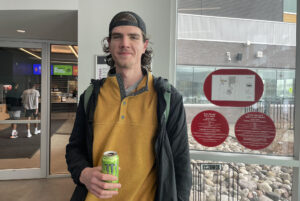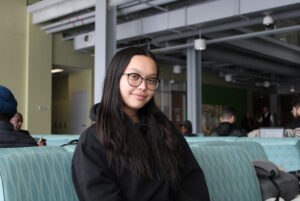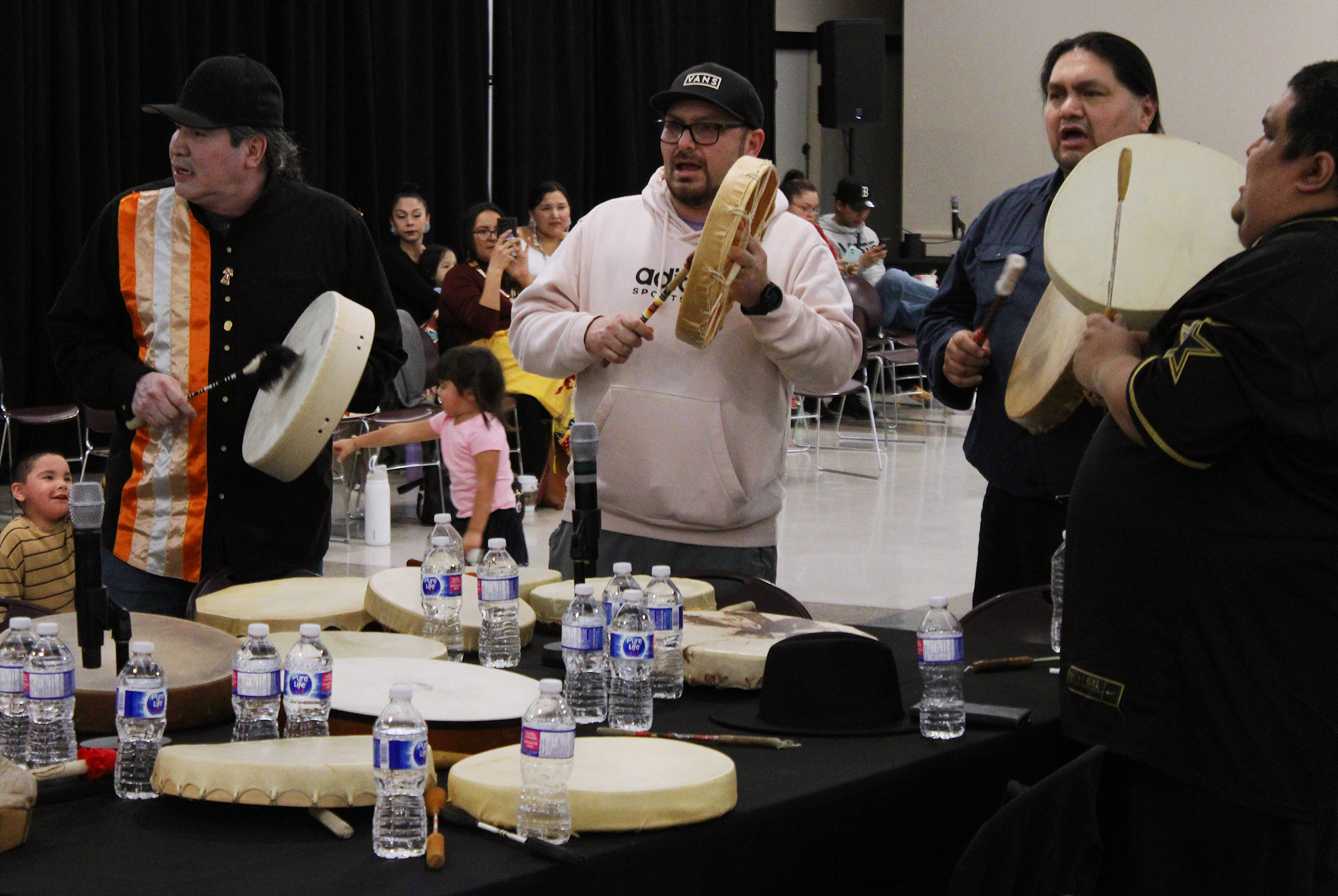
A sudden drop in temperatures brought a snowstorm to Ottawa on April 4, making commutes tougher for Algonquin College students.
Many OC Transpo buses were running off schedule. Markya Dorcilhomme, a Level 1 public relations student, said her bus showed up unexpectedly early.
“It kept getting delayed so I thought it was fine, but I ended up having to run,” said Dorcilhomme on campus. “My bus got stuck in the road twice on the way here.”
According to Lilian Ching, a Level 1 mobile application design and development student, a bus on Route 86 didn’t show up at all.
“I had to change the route to go to school,” said Ching.
Even students who don’t bus were delayed by the snow.
Evan Tavnel, a Level 1 student in the welding and fabrication techniques program, drove to class.
“It definitely took longer to get here,” said Tavnel. “I woke up late so I had to wipe off my car and that wasn’t really fun.”

Lois Caracas, a Level 1 public relations student, walked to class.
“Walking to College Square was hard,” said Caracas. “All the wind and snow and rain. I know other people had worse delays. Half of my class didn’t show up.”

The delays created various disruptions in class activities. Greg Keough, a Level 1 business student, was late for an important project.
“I did have a presentation today for my class and this weather affected it,” said Keough. “I was late and I was supposed to go first.”

Benjana Poudel, a Level 1 personal support worker student, nearly had the same experience.
“I waited for the bus like for 45 minutes today,” said Poudel. “It didn’t come, so I had to book a ride because I had a presentation.”
Julia Massey, a Level 4 business marketing student, said, “We didn’t have any classes cancelled, just half of them were not in attendance.”

In addition to creating many practical concerns, the storm disappointed students who were hoping for and expecting spring weather.
“I wasn’t looking forward to snow in April because, you know, last week it was beautiful and we were all wearing jackets, but this week, today, I need to get those winter things out,” said Simran Sanga, a Level 2 project management student.
“They really gave us hope [for spring] and then snatched it away,” said Dorcilhomme.
With reporting by Kaitlyn Lemay, Siobhan Rollo, Claire Donnan, Nathalia Lencioni, Chantal Lapierre, Yuye Jiang, Zixuan Li, Zhiqi Zhou, Laiyiady Lam and Caroline Kirkey

Local
CTV: Two Ottawa police officers were left with serious injuries after their cruiser was struck by a suspected stolen car on Friday evening near Woodfield Drive and Merivale Road in Ottawa’s west end.
A statement by police on Tuesday says officers observed a vehicle that was reported stolen at approximately 11:15 p.m.
One youth passenger was charged with possession of property obtained by crime and failure to comply with a release order.
The second youth passenger was charged with possession of property obtained by crime.
National
CBC: Ontario’s premier Doug Ford slammed the new federal carbon tax hike on Tuesday April 2, at a news conference in East Gwillimbury, Ont.
“We stand against the carbon,” said Ford. “We know Ontario businesses can’t afford this costly burden.”
Drivers will pay extra 3.3 cents per litre at the gas pumps.
Prime Minister Justin Trudeau has said that while the price of pollution is rising, so is the Canada Carbon Rebate.
The increase will also mean larger cheques to help families offset the higher cost of fuel.
In Ontario, a single-person household will receive $140 and a family of four will receive $280 every three months, said Trudeau. Families are next set to receive a cheque on April 15.
International
Global News: Bird flu continues its global spread according to World Health Organization, wiping out sea lions and millions of birds.
Concerns remain on a high alert regarding the viruses potential risks to human health.
The latest development Centers for Disease Control and Prevention on Monday reported a human case of avian influenza in a person who had contact with dairy cows in Texas presumed to be infected with the virus.
“So, this highly pathogenic avian influenza has been circulating around the world at a very high rate for a number of years now,” explained Matthew Miller, the director of the Degroote Institute for Infectious Disease Research at McMaster University.

Can the pressure to adopt a political stance lead to real change, or does it merely result in superficial support?
Engaging in discussions, whether for or against a cause, should be open to those who are either capable of or choose to speak on the matter, rather than coercing individuals into adopting a stance.
Being compelled to voice an opinion does not equate to genuine support but rather is a performative action driven by peer pressure.
Advancements in technology have significantly improved access to information. The rise of social media platforms has heightened global awareness of various issues, shifting the landscape of how information is consumed and trusted.
This shift has led to a decline in reliance on legacy media sources, as a growing number of individuals now place their trust in the information disseminated through social networks.
That being said, it’s important to note that not all people are well-informed about global issues or politics, nor are they equipped to discuss said topics.
In recent years, we’ve seen an increase in public pressure to support or take a stance on the war in Ukraine, announce if you’re vaccinated or protest against the occupation in Palestine.
In an article published in the McMaster Undergraduate Journal of Psychology in October 2022, Amira Abdalla found that the fear of cancel culture leads to an increase in online activism.
“More often, those who engage in online activism treat it as a trend and fail to enact real and positive changes in regard to social causes,” said Abdalla.
When people are pressured to take a stand, their support may become performative. It’s a case of going along with the crowd to avoid scrutiny, which doesn’t truly help the cause.
However, public pressure towards for-profit corporations and political entities is necessary as they often finance or are responsible for the atrocities of the world and hold the power to assert change.
As seen during the Black Lives Matter protests and the Free Palestine protests, boycotting brands is impactful. However, it’s not sufficient to just pressure brands to acknowledge social issues without a detailed plan of action.
Melissa Jiménez, digital content coordinator at King’s College, shares that organizations have realized that making empty statements can damage their reputation a necessary plan of action is required.
“Voicing support without meaningful actions to back it up is not wise to do from a reputational standpoint,” said Jiménez. “It causes more harm to the reputation. People are more savvy when it comes to the brands that they support.”
Genuine support for any cause should come from a place of understanding, a personal connection to its values and a voluntary decision to advocate for change.
Superficial support might look good in terms of public perception, but it doesn’t build a strong foundation of advocates who can push for sustainable change.

Cringe culture is a relatively new thing to members of “Gen Z.” We’ve all seen them suggested to us on social media: cringe compilations, try not to cringe challenges, entire meme pages dedicated to those they deem “cringey”. The word eventually makes you, well, cringe. However, I need to ask, why does all of this matter anyway?
Cringe culture is a way of reintroducing shame-guilt-fear culture. Shame-guilt-fear culture is a sociopolitical term which describes the idea of excluding people because you feel that they do shameful things, they do things that they should feel guilty about or they do something that makes others fear them.
While it has its place, shame-guilt–fear culture eventually became a way of vetting out “undesirable” people in the 19th century. It would be an easy way to whistleblow people of colour, queer individuals, neurodivergent people, immigrants, the list goes on.
With the sudden fear of cringe culture further developing, it just creates more outsiders. Do you dare to like a cartoon made for children? That’s cringe! Do you dress differently than our social norm? That’s cringe! It’s another way to ostracize people.
Cringe culture is also an excuse to cyber bully people at large. If you post something that someone deems “cringe,” it puts you at risk of being plastered in a cringe compilation. You become a jester because of your passion. The worst part is that the concept of “cringe” is subjective, as most terms are.
So you — yes, you who dared to post a TikTok about something you are passionate about — can be selected at random by someone who doesn’t enjoy your passion. Just like that, you’re made into a public spectacle. The comments aren’t any better. They take the opportunity of screen anonymity to tear people apart. The more vulnerable a person seems, the better.
I’ll tell you something, a secret some of you may not know. All of us are cringey. If you dare to be an individual, you’re subject to being labelled cringey. There’s always something you do that’s cringey. For some, it’s their interest in anime. For others, it’s the way they get excited to ride a rollercoaster. Everyone is cringey.
The Disney movie Turning Red is a good example of how cringe culture is received by the general public. When the movie came out, there was a lot of controversy surrounding the way the characters acted. Mei, our main character, is your average preteen girl. She likes boy bands. She likes to make silly videos with her friends. She tries her best in school. She’s got weird crushes on grody teenage boys. But this was enough for audiences to get upset. Her crushes are cringe. The way she dances on tape is cringe. The way they talk about her going through puberty is cringe. The way she likes to sing boyband songs with her friends is cringe. That’s right, not even fictional characters are immune to the label of being cringe.
If there was one thing I’d ask you to take away from this, is that cringe culture doesn’t matter. It’s always existed, but we’ve always survived it. I promise you that being cringe isn’t the end of the world. Let yourself be passionate and vulnerable. Disregard those who hate you for it. Because for every bully that calls you cringey, there are lots of people who are cringey just like you. Doing “cringey” things doesn’t make you cringey. It just makes you an individual.

In 2023, Canada had over one million international students in all education levels according to the Canadian Bureau for International Education. In the early months of 2024, the Canadian Ministry of Immigration announced a two-year intake cap on international students, crediting their decision to concerns regarding predatory practices by some educational institutions and lack of support for the students. However, the statement also blamed them for some of the biggest and long-standing challenges Canada faces today.
The government’s official news release, along with the media coverage of the announcement, stated that rapid increases in the number of international students arriving in Canada put “pressure on housing, health care and other services.”
I believe this to be neither accurate nor fair, but overly simplistic, untrue, and an unnecessary contribution to already growing xenophobic rhetoric, which will disproportionally affect people of colour.
International students deserve access to the support and services they need to prosper in Canada. The majority of those students cannot financially compete with Canadians for homes or rentals. After graduation, they continue to earn less than domestic students, according to Statistics Canada.
The idea that international students are “ideal immigrants” has been commonly broadcasted when the country requires skilled labour or an economic boost, however, the idea that they contribute to issues such as housing and healthcare access decline has also been commonly spread. I believe given the contrast between these ideas, the rate of recurrence they are exchanged in public opinion fosters an unstable atmosphere that is harmful to students’ mental health.
The ideal immigrant idea was first used in the mid-2000s due to a policy change, according to the Journal of International Migration and Integration.
“Relative to other classes of immigrants, policy makers assume that [international students] are ‘ideal immigrants’ to Canada because their experiences within the Canadian post-secondary education system is assumed to give them the essential skills needed to integrate successfully into the workforce upon graduation,” according to a research paper called International Students as ‘Ideal Immigrants’ in Canada: A disconnect between policy makers’ assumptions and the lived experiences of international students.
Governmental and public discourse that implicitly or explicitly assigns blame for nationwide concerns such as the housing crisis to immigrants and international students shifts the responsibility away from those truly responsible: elected officials with the power to enact change in housing legislature and foreign investors indiscriminately adding to their real estate portfolio.
This tactic also draws attention away from immediate and long-term solutions elected officials could take to increase the housing supply.
The consequences for post-secondary institutions have been the focus of reports since the announcement of the cap. However, the same information sources have been consistently remiss in considering the international students — many of whom struggle to get by in Canada — have been commodified for decades, and are clearly seen as a revenue source in place of weaning or missing provincial investments and grants.
Experts believe the current housing obtainability and affordability crisis Canadians are facing can be sourced back to bailouts and policy changes issued after the global financial crisis and has been in the making for decades, according to the research paper: Canada’s Housing Bubble Story: Mortgage Securitization, the State, and the Global Financial Crisis.
Canada is often selected as a study destination due to its image as a safe and inclusive society, but if international students continue to be used as scapegoats for nationwide issues, I believe that will quickly change. The issue of insufficient resources for the number of international students is an issue entirely manufactured by the Canadian government’s policies and should be spoken of as such.

It’s the first day of classes, and I’m running late.
I tap my foot impatiently at Hurdman Station, waiting on the 88 bus to take me the 28 stops from the train station to campus. Since I got to the station, the 88 has skipped two scheduled departures.
I left my house in Sandy Hill an hour early thinking this would be enough, although I was clearly, sorely mistaken.
The bus finally reaches Hurdman with 30 minutes to spare, and I burst into my first class as it begins. Since that first day, I’ve left the house an hour and a half early just to make it to campus 15 minutes early for class, and I’m not alone doing this. Indeed, the 88 in particular is absolutely packed morning and night, with the bulk of people getting on or off at campus.
Originally from Newfoundland and Labrador, where buses seem to take longer than just walking to your destination, I was quite unused to the idea of relying so heavily on public transit. To that end, I was – and still am – reticent of the idea of relying on transit that is this unreliable, skipping departures, running late, and constantly packed.
Simply put, the commute to Algonquin is terrible. Is there anything the college can do to fix this?
From downtown Ottawa, there are several main bus routes that service Algonquin College. The first three, buses 73-75, depart from the Tunney’s Pasture station frequently, but require you to go further on the train and drop students off at Baseline, a 10-minute walk from most campus buildings.
That just leaves the Terry Fox bus: The 88, which departs from Hurdman station every 15 minutes (allegedly). On Reddit, this bus is lovingly called the LateyLate bus, which replaced the former 118 (OneLateteen) bus route.
In the future, the City of Ottawa hopes to expand the LRT as far as Algonquin College, rendering these long haul bus routes less essential. But until then, surely the college can do more?
Aditya Mishra, the new Board of Governors student representative, believes the college can do more for commuting students, and that currently, buses don’t come often enough.
“Weekdays it [buses serving the college] is fully packed, like a matchbox,” said Mishra. “I think buses every 15 minutes, should be reduced to like, seven minutes or something.”
In addition to this, Algonquin College has a Transportation Strategy. Within this 2017 document prepared by Urban Equation, they stress the importance of improving transit to the college, and previous steps they had already taken to make the commute more reliable.
“In 2011, the college partnered with OC Transpo to redirect Route 118 [now 88] through the Ottawa campus, and add two new bus stops,” said Urban Equation in the document. They additionally planned for the expansion of the LRT and what this would mean for transit to the college.
These steps have admittedly already made significant improvements to the commute to Algonquin. However, with the LRT expansion looming further and further away, Mishra believes the college should do more to help students now.
“In my opinion, I think the college should talk to OC Transpo about the frequency because, they can do that,” said Mishra.
As it stands, I’ve restructured my commute to campus. Sick of waiting for buses in the cold, I instead brave the extra time on the train and the longer walk to take the 73-75 in the mornings. It’s much less packed, and actually comes when I expect it to. I have to admit, from Tunney’s Pasture at least, buses are dependable and fairly quick.
However, a lot more will have to be done before I can describe my commute as anything close to “reliable.”

Despite graduating from Algonquin College’s paramedic program, Alan Wong decided he didn’t actually want to be a paramedic. Instead, Wong wanted to focus on a career he would be passionate about.
After graduating in 2011, Wong started working with OC Transpo. Working with buses, however, was not Wong’s dream either.
Nearly a decade later, Wong left OC Transpo and finally started pursuing something he is passionate about: veganism.
Wong started volunteering at VegOttawa, a local plant-based non-profit, in the summer of 2023. On March 24, 2024 he became president of VegOttawa.
“I just saw there was a need for some direction and organization within VegOttawa, so I just wanted to step up and do what I could,” said Wong. “It’s also experience I’m hoping to gain to help me and my career.”
VegOttawa’s mission is to promote veganism in Ottawa. They do this by hosting events such as Beyond Meat barbeques and planning hikes for vegans to get together and hang out.

Members of VegOttawa receive discounts at various vegan-friendly businesses around Ottawa that have partnered with the non-profit. Recently, VegOttawa started giving student memberships at a 50 per cent discount.
“We have noticed many college and university students in Ottawa getting involved in animal rights and sustainability associations,” said Joyce Santos, vice president of VegOttawa. “It’s so encouraging to see so much passion and dedication to this cause. We wanted to acknowledge the student community.”
For VegOttawa, veganism isn’t just a diet, it’s a lifestyle. They are dedicated to promoting how veganism can help the environment and animals.
Last year broke numerous records related to climate change, including being the hottest year on record and having the highest concentration of greenhouse gases held in the atmosphere, according to the World Meteorological Organization.
In 2022, carbon dioxide concentrations in the atmosphere were 50 per cent greater than they were in the pre-industrial era. The amount of carbon dioxide in the atmosphere continued to grow in 2023, according to the WMO.
As long as carbon dioxide and other greenhouse gases such as methane continue to get trapped in the atmosphere, global temperatures will continue to rise, said the WMO in a press release.
VegOttawa believes that going vegan will produce less greenhouse gases, which will help the environment.
“Animal agriculture contributes largely to climate-warming greenhouse gases, as well as deforestation, water pollution from animal agriculture runoff and soil degradation,” said Santos. “Eating plant-based is beneficial to the environment and also an ethical choice for those who have compassion for animals.”
Wong pointed out a study published by Science, an academic journal, which shows that despite meat and dairy farming using 83 per cent of farmland and releasing around 60 per cent of greenhouse gas emissions, it only provides 18 per cent of calories.
“[It] is ridiculous, four-fifths of our land is making one-fifth of our calories,” said Wong. “In general, the best animal products, in terms of emissions, land use and water use, are still worse than the worst performing plant products.”
However, some students are finding it difficult to go plant-based.
Aryan Chandel is a fourth-level hospitality – hotel and restaurant operations management student. Growing up in India, Chandel was raised as a vegetarian. However, upon moving to Canada, Chandel realized it is more difficult to be plant-based in Canada as vegetarian food here isn’t as good as the food in India. Chandel has since started eating meat.
“The best vegan and vegetarian food is Indian, but Indian food is quite expensive,” said Chandel.
The rising cost of food is part of why VegOttawa wanted to provide students with a discounted membership.
“We know that, especially nowadays, food is not cheap, especially going out for food,” said Wong. “We are at least trying to help out a little bit.”
Wong never returned to school after finishing the paramedic program at Algonquin College. Despite this, he has found a career he is passionate about.
When Wong isn’t promoting veganism with VegOttawa he is doing research for an animal-focused organization, a job he absolutely loves.

Once the paint was set up, chaos rose and students threw colourful powder at each other, dumping red, green and orange colour bags on each others heads.
Over a hundred joyful Algonquin College students gathered in front of the E-building at 1 p.m. on March 25 to celebrate the Holi festival.
Holi, a Hindu festival of colours, is a celebration of good over evil. This festival has many meanings to it. One is about the story of how Krishna fell in love with the godess Radha but feared that she wouldn’t love him due to this blue skin, however Radha let Krishna dye her skin blue and they became a true couple.
When Leah Grimes, one of the event coordinators, was asked to describe the event.
“The event was lively and colourful,” Grimes said. “I wish we had more paint. Everyone was so excited.”
Students lined up to get their white T-shirts provided by the event. The event was coordinated by the Students’ Association.
No matter how far people were standing away from the festivities, they were getting colour on them. Students were spreading colourful powder on anybody they saw. If you had no colour, you were going to get some.
Everyone was smiling while covered in powder, dancing, filming and taking pictures.
There were paint bombs being shot by students, which would make colourful clouds.
“It was fantastic to see all this positive energy around the school,” said Tryla Thorpe, an early childhood education student.

The students got excited and the all crowded in front of the Student Commons, and “they created their dance floor,” according to Grimes.
A DJ at the event played all kinds of music to get the students dancing and singing along, and a small rave was started in front of the Student Commons.
The festival was scheduled to end at 3 p.m., but students were still dancing until around 40 minutes later.
After the event, the pavement in front of the E-building was covered in bright colours, and the grass in front of the student commons was painted red.
Students got in their cars, covered in paint, and still celebrating from their vehicles, with people throwing powder from their vehicles’ sunroofs.

The Round Dance ceremony was put together by the Mamidosewin Centre for Algonquin College students to gather, socialize, remember loved ones and heal together on March 22, from 5 p.m. until midnight.
This event has been ongoing for the past four years and more people have continued to attend every time the event has been held. This year, there was an approximate total of 200 people.
The Round Dance comes from the west, and it is traditionally held to remember those who are not with us today. Nowadays, it can be held for different reasons, such as birthdays.
Just days before this event happened, a car collision killing five people happened in Waswanipi, a northern Cree community. A few people at the Round Dance were connected to those lost on that day.
“As we gather today, let’s remember those from the accident and dance for them,” said Fred McGregor, MC of the event.
At the beginning of the event, photos cannot be taken as it would be disrespectful towards the opening pipe ceremony performed by the pipe carrier, Vince Kicknosway from Walpole Island, First Nation.
The pipe ceremony is held with tobacco and smudge to cleanse everyone of negative energy to bring forth healing and to begin the Round Dance.
“The connection for the students is important as well as the culture and what we want to give,” said McGregor.
As the opening to the ceremony ended, the rest of the evening started. The invited singers and drummers began to play the traditional music. As the drums were being pounded and as they sang, the people who came to the event danced.
The dance circle was never empty as this was the healing part.
“For me, I think the most important part of the ceremony is to socialize,” said Shayna Shawogonabe, a museum studies student and Mamidosewin Centre worker.
Food was provided for the people late at night as Indigenous ceremonies traditionally end at midnight. They had pepperoni and vegetarian pizza for whoever was hungry.
At the end of the event, the singers performed the closing song to the ceremony to end the night.
“I hope this continues to happen as this has been going on for the past four years. We used to be scattered but now it’s a lot more organized,” said Randy Kakegamick, student advisor from Mamidosewin Centre.
You have been subscribed. Thank you!